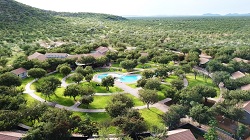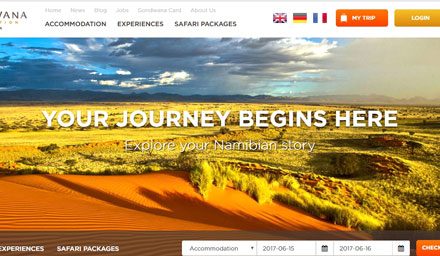
The oasis of Damara Mopane Lodge

By Gondwana Collection.
If it is charm you are after, there is a very good chance that you will find it at Damara Mopane Lodge, a veritable oasis in Damaraland. Built-in the labyrinth design of a traditional royal African kingdom, Damara Mopane Lodge has more extraordinary features. It grows its own greens and every chalet sports its own vegetable and herb garden.
Thirty kilometres east of Khorixa the lodge has become a welcome stop for those visiting the Twyfelfontein rock engravings and travelling in the north-western corner of Namibia. It was added to the Gondwana Collection in 2010 when tourism was booming and there was a demand for more accommodation in the area. Encouraged by the tour operator Sense of Africa, Gondwana began to look for property in the Twyfelfontein surrounds. At the time there was uncertainty about developing on communal land and the company opted to purchase commercial land instead.
This would change in the next decade when Gondwana would build or take over operation of eight community lodges – Palmwag Lodge, Omarunga Epupa-Falls Camp, Etosha King Nehale Lodge, Hakusembe River Lodge, Namushasha River Lodge, Zambezi Mubala Lodge and Camp, and Chobe River Camp – employing hundreds of people, with thousands benefiting indirectly, becoming the biggest contributor to communal areas in the tourism industry in the country.
The team discovered that the farm Witklip, situated between Khorixas and Outjo, had 400 hectares of land that had been cut off by the tar road and they approached the owner Dudu Murowa, who agreed to sell. The attractive piece of land was situated in mopane woodland and the team selected a sandy spot where fewer trees grew to build the lodge.
Continuing a tradition of being innovative, they decided to build the lodge in a labyrinth or semi-circular maze-like design with each of the spacious chalets resembling a small free-standing house with its own front stoep and garden. Telané Greyling drew up the designs and Gondwana used its own building crew for the construction. This would be the last lodge in the Collection to be built in-house as the company expanded in subsequent years, becoming increasingly professional and engaging architects and construction teams to build the lodges.
With a good supply of water, a dedicated team of gardeners was employed and vegetable gardens were planted around the chalets and periphery of the lodge. These have delighted guests and provide ample fresh greens on the table. Today fruit trees bear succulent grapefruit and zany scarecrows looking over rows of spinach and beetroot, while bright sunflowers happily swivel their large yellow heads to follow the sun.
Building the lodge proved challenging because of the hard dolerite rock that lies below the thin layer of surface sand. Although the dolerite provided a solid base for the building foundations, jackhammers were needed to break through the rock to make trenches for the drainage system and to create the large swimming pool, which lies invitingly between the central area and the chalets. A water recycling plant was built to clean the wastewater for the lawn and garden, and the access road was paved. When the main construction work was completed, a sundowner deck was built on the nearby koppie. From this lofty spot, an expansive vista over the mopane woodland extends all the way to the Brandberg Mountain in the west. It is a popular afternoon activity to stroll up to the deck for a sundowner drink and to watch the sunset before descending to the lodge for their delicious buffet supper.
Damara Mopane Lodge was built during a year of severe drought. The land was still dry when the invitations were sent out to operators at the end of 2009 for the opening of the lodge and Gondwana invited guests to join in a rain dance to bring the blessing of rain to the arid area. It seemed that the rain gods must have been paying attention. On the day of the opening the heavens opened and rain bucketed down. It was an auspicious beginning for a lodge that would become an oasis in the Kunene Region as its vegetable gardens grew and its garden flourished.
Today, eleven years later, Damara Mopane Lodge has become a much-loved destination for a two-night stay, providing a welcome base for guests visiting the Twyfelfontein rock engravings. After a visit to the engravings, they return to relax on the lush grass next to the gigantic swimming pool, soaking up the peace – and are loathe to leave. Bright flowers, sunflowers, robust mopane trees, vegetables and herbs add to the enchantment, imbuing a sense of well-being. The lodge has become a place to refresh, recharge and dine well before heading out onto the roads to continue exploring the wonders of Namibia.












































